BBC News at Six presenter Clive Myrie sparked health worries amongst viewers after they noticed his 'droopy eye' during Monday night's broadcast. Concerned fans took to social media to inquire about his well-being, prompting the 60 year old journalist to clarify the situation.
He tweeted that he was dealing with an infection and had even considered donning an eye patch for the show, but "the boss said no". A medical expert has now weighed in on what might have caused Myrie's droopy eye, and the potential implications.
Dr Alasdair Scott, a science director at Selph, explained that eyelid drooping is known as "ptosis" and can stem from various factors. While ptosis can be congenital due to underdeveloped muscles, it more often occurs later in life, particularly affecting those over 70.

Dr Scott noted, "As we age, the skin and muscles around the eyes stretch and weaken causing drooping of the eyelid," adding that up to one in five adults over 70 may experience some level of ptosis. With over 9 million people in the UK aged over 70, this could mean nearly 1.8 million individuals are potentially affected by the condition.
Dr Scott also mentioned that any swelling around the eye, whether from injury or infection such as conjunctivitis, a chalazion, or stye, could result in ptosis, reports Surrey Live.
Dr Scott, discussing Clive's condition, believes his droopy eye could be due to a mix of age-related weakness and infection, which should improve as it heals. He further explained that conditions like myotonic dystrophy can weaken the eyelid muscles.
Damage to the oculomotor nerve of the eyelid, possibly caused by trauma or diabetes, might also contribute. The doctor also mentioned damage to the "sympathetic" nerves supplying the eyelid as another potential cause.
"This is called Horner's syndrome and can be caused by injury to the nerves (for example during surgery on the thyroid gland) or by a stroke," he clarified. Myasthenia gravis, a rare autoimmune condition affecting nerve conduction, is another common factor linked with ptosis.
The NHS provides advice for anyone worried about eye problems, recommending they contact their GP if:
- your swollen eyelid is red, hot, painful, tender or blistered
- your eyelid droops suddenly
- you cannot open your eye or keep it open
- the pain is in your eye (not your eyelid)
- the white of your eye is very red, in part or all over
- you have eye symptoms and a headache or you feel sick or are being sick
- a newborn baby (less than 1 month old) has a sticky, red eye
- you're sensitive to light (photophobia)
- your eyesight changes – for example, you have blurred vision and see wavy flashing lights, zigzag patterns or coloured spots or lines
- you have a very high temperature, or feel hot and shivery, or you feel generally unwell
- you think it's an allergic reaction
/cdn.vox-cdn.com/uploads/chorus_asset/file/23028907/dseifert_20210323_4485_0004.jpg)

.png)





/cdn.vox-cdn.com/uploads/chorus_asset/file/25262608/DSC06592.jpg)








 English (US) ·
English (US) ·